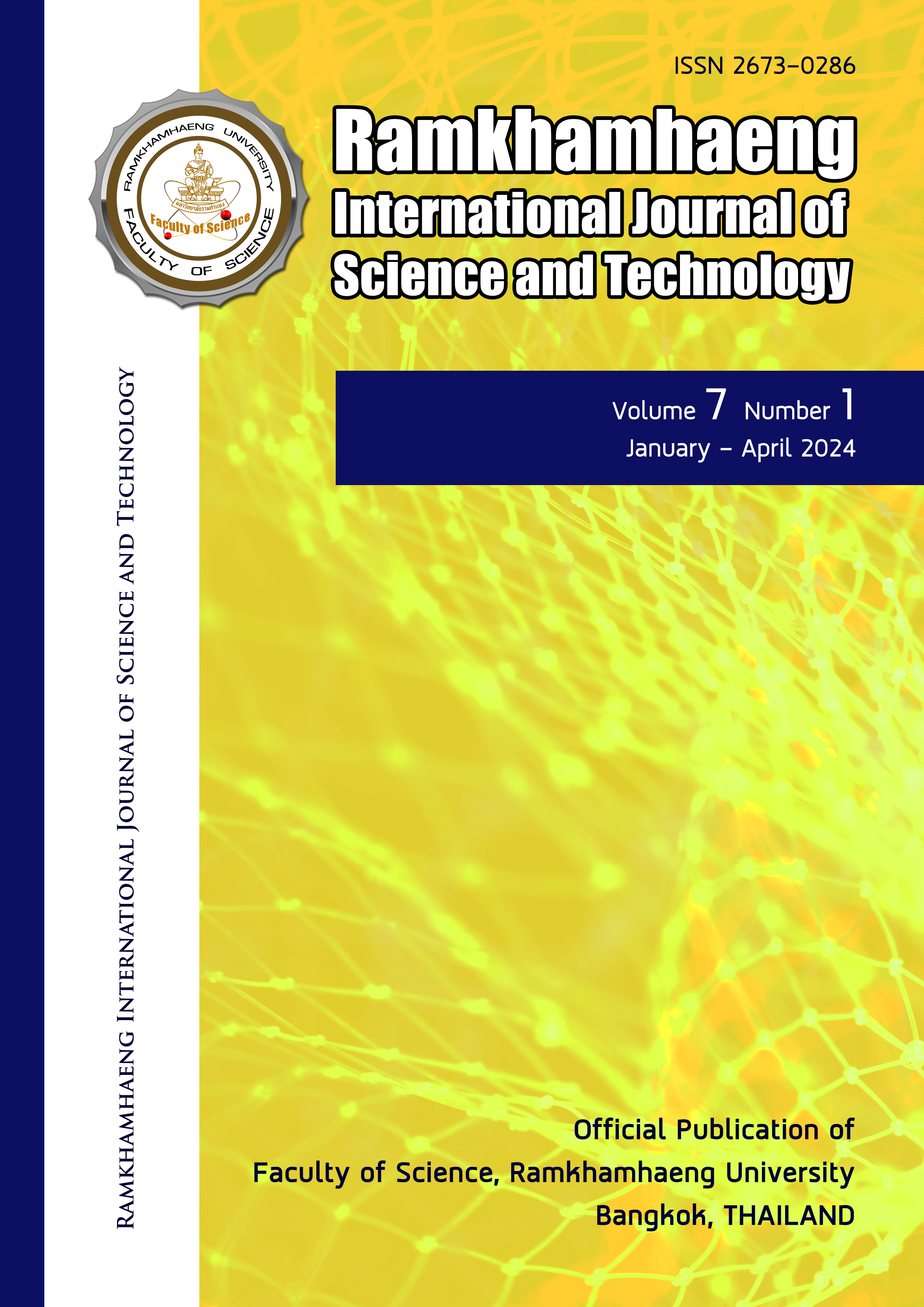Survival and growth rate of coral micro-fragments for coral reef restoration in Chonburi Province, the Upper Gulf of Thailand
Keywords:
Micro-fragmentation, Coral restoration, Growth, Survival, Gulf of ThailandAbstract
Coral reefs provide very important ecosystem services, especially nursery grounds for economically important species, tourism sites and coastal defense. Coral micro-fragmentation is a new technology that allows coral fragments to have a high growth rate. This study aims to compare the survival and growth rates of coral micro-fragments among four species, i.e, Porites lutea, Favites abdita, Galaxea fascicularis and Leptastrea purpurea in a coral nursery plot at Ko Khang Khao, Chonburi Province, the Upper Gulf of Thailand. The results showed that all micro-fragment with initial sizes between 1 and 3 cm had survival rates exceeding 90%. The mean survival rate of F. abdita was the highest (97.29%), followed by L. purpurea (96.89%), G. fascicularis (96.14%), and P. lutea (94.60%). The highest growth rate was observed in the coral micro-fragments with an initial size of 1 cm, which were then followed by 2 and 3 cm (One-way ANOVA, p < 0.05). This study highlights the importance of active coral reef restoration using micro-fragmentation technique as a newly developed technology to elevate the efficiency and effectiveness of coral restoration projects as well as enhancing community based eco-tourism and carbon neutral tourism or net zero tourism.
References
Bayraktarov E, Stewart‐Sinclair PJ, Brisbane S, Boström‐Einarsson L, Saunders MI, Lovelock CE, Wilson KA (2019) Motivations, success, and cost of coral reef restoration. Restor Ecol 27(5): 981-991
Bindoff NL, Cheung WWL, Kairo JG, Arístegui J, Guinder VA, Hallberg R, et al. (2019) Changing Ocean, Marine Ecosystems, and Dependent Communities. IPCC Special Report on the Ocean and Cryosphere in a Changing Climate. Geneva: IPCC.
Bruno JF, Selig ER (2008) Simulated coral reef restoration: still lots to learn on how to heal our reefs. Frontiers in Ecology and the Environment 6(8), 485-496
Chaithanavisut N, Sutthacheep M, Pengsakun S, Klinthong W, Chamchoy C, Aunkhongthong, W (2023) Growth and survival of coral micro-fragment in Chonburi Province, the Upper Gulf of Thailand. Ramkhamhaeng International Journal of Science and Technology 6(3), 31-44
De’ath G, Fabricius KE, Sweatman H, Puotinen M (2012) The 27-year decline of coral cover on the great barrier reef and its causes. Proc. Natl. Acad. Sci. U.S.A. 109, 17995–17999. doi: 10.1073/pnas.1208909109.
Forsman ZH, Page CA, Toonen RJ, Vaughan D (2015) Growing coral larger and faster: micro-colony-fusion as a strategy for accelerating coral cover. PeerJ, 3, e1313.
García‐Medrano D, López‐Pérez A, Guendulain‐García S, Valencia‐Méndez O, Granja‐Fernández R, González‐Mendoza T, & Torres‐Hernández, P (2023) Gardening Pocillopora spp. fragments and their potential for rebuilding reef systems in the southern Mexican Pacific. Restoration Ecology, 31(8), e14006
Harrington L, Fabricius K, De'ath G, Negri A (2004) Recognition and selection of settlement substrata determine post-settlement survival in corals. Ecology 85(12): 3428-3437. https://doi.org/10.1890/03-0744
Henriksen CP (2020) A Regional Assessment of Coral Restoration within the Western Atlantic with a Case Study of Barbados (Doctoral dissertation, University of Essex).
Hoegh-Guldberg O, Mumby PJ, Hootjes A, Steneck RS, Greenfield P, Gomez E, Lough DM (2007) Coral reefs under rapid climate change and ocean acidification. Science, 318(5857), 1737-1742
Hughes TP, Kerry JT, Alvarez-Noriega M, Alvarez-Romero JG, Anderson KD, Baird AH, et al. (2017) Global warming and recurrent mass bleaching of corals. Nature 543:373
Knapp ISS, Forsman ZH, Greene A, Johnston EC, Bardin CE, Chan N, Wolke C, Gulko D, Toonen RJ (2022) Coral micro-fragmentation assays for optimizing active reef restoration efforts. PeerJ, 10:e13653 DOI 10.7717/peerj.13653.
Lirman D, Schopmeyer S (2016) Ecological solutions to reef degradation: optimizing coral reef restoration in the Caribbean and Western Atlantic. PeerJ, 4, e2597. https://doi.org/ 10.7717/peerj.2597
Lock C, Bentlage B, Raymundo LJ (2022) Calcium homeostasis disruption initiates rapid growth after micro‐fragmentation in the scleractinian coral Porites lobata. Ecol Evol 12(9): e9345
Lock C, Bentlage B, Raymundo LJ (2022) Calcium homeostasis disruption initiates rapid growth after micro‐fragmentation in the scleractinian coral Porites lobata. Ecol Evol 12(9): e9345
Moberg F, Folke C (1999) Ecological goods and services of coral reef ecosystems. Ecol. Econ. 29, 215–233. doi: 10.1016/s0921-8009(99)00009-9.
Page C, Perry R, Lager CVA, Daly J, Bouwmeester J, Henley EM, Hagedorn M (2023) Tank fouling community enhances coral microfragment growth. PeerJ, 11:e15723 http://doi.org/10.7717/peerj.15723.
Page CA, Muller EM, Vaughan DE (2018) Microfragmenting for the successful restoration of slow growing massive corals. Ecol Eng 123: 86-94. https://doi.org /10.1016/j.ecole ng.2018.08.017
Raker C, Olmeda-Saldaña M, Williams SM, Weil E, & Prada C (2023) Use of predator exclusion cages to enhance Orbicella faveolata micro-fragment survivorship and growth during restoration. Frontiers in Marine Science, 10, 1122369.
Steinberg AA (2021) Optimization of grow-out of bouldering coral microfragments: land vs. offshore nursery. Master's thesis. Nova Southeastern University. Retrieved from NSU Works, (44) https://nsuworks.nova.edu/hcas_etd_all/44
Sutthacheep M, Chaithanavisut N, Sangsawang L, Pengsakun S, Klinthong W, Aunkongthong W, Limpichat J, Yeemin T (2023) Growth rates of coral micro-fragments from a coral restoration project at Koh Larn, Chonburi Province, Thailand. RIST 6(1):30-40
Tortolero-Langarica JA, Rodríguez-Troncoso AP, Cupul-Magaña AL, & Rinkevich B (2020) Micro-fragmentation as an effective and applied tool to restore remote reefs in the Eastern Tropical Pacific. International Journal of Environmental Research and Public Health, 17(18), 6574
Wilkinson CC (2004) Status of Coral Reefs of The World: 2004. Townsville: Australian Institute of Marine Science (AIMS).
Yeemin T, Chaithanavisut N, Sutthacheep M, Pengsakun S, Klinthong W, Chamchoy, C, Aunkhongthong W (2023) Growth and survival of coral micro-fragment in Chonburi Province, the Upper Gulf of Thailand. Ramkhamhaeng International Journal of Science and Technology, 6(3), 31-44
Downloads
Published
Issue
Section
License
Copyright (c) 2024 Ramkhamhaeng International Journal of Science and Technology

This work is licensed under a Creative Commons Attribution-NonCommercial-NoDerivatives 4.0 International License.
Copyright Notice: a copyright on any article in the published journal is retained by the Ramkhamhaeng International Journal of Science and Technology. Readers or Users grant the right to use of the Article contained in the Content in accordance with the Creative Commons CC BY-NC-ND license and the Data contained in the Content in accordance with the Creative Commons CC BY-NC-ND.



